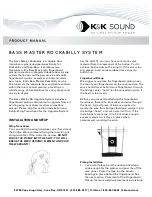
Powered by Safety
®
13
Installation
01.4IB.48040C
Ch 4 Installation
The installation of the BriteSpot™ Fiber-Optic
Temperature Measurement System is comprised
of several steps. The G3 Conversion Module and
Fiber-Optic Probe can be installed independently
of each other, and hence the order of certain
aspects of the installation are at the user’s
discretion. Many of the images will show
installation on medium voltage switchgear, as
this provides a typical installation. However,
the principles of installation can be carried over
to many other applications where temperature
monitoring is needed. Other examples include:
wiring splices, circuit breakers, motor control
centers, bus duct, dry-type transformers and so on.
A. S
elect
A
l
OcAtiOn
Of
i
ntereSt
BriteSpot can measure temperatures on any
equipment within its operational range. The
start of the process is to select a Location of
Interest (LOI). The tip of the fiber will eventually
be placed at this location and secured via the
fixture.
Some recommended principles to follow when
selecting the LOI include:
1. The LOI should ideally be as close to a
potential source of failure as possible. For
example, if a splice or bolted connection is
present and critical, consider mounting the
fiber sensing tip right at, or adjacent to, the
connection point.
2. The probe can measure temperatures in
locations that are not visible, therefore
consider locations where infrared
monitoring will not be effective. In many
situations, important connections are
hidden behind ducting and sheet metal.
Main Bus compartments are an ideal
example as they cannot be viewed in
operation.
3. There must be a method for affixing one of
the various fixture options to the LOI. Each
fixture type has specific requirements for
proper attachment.
4. There must be a continuous path going
from the LOI to the mounting location
for the Conversion Module which can be
followed by the fiber. This will be termed
the “Fiber Path”.
There are additional aspects that need to be
considered before proceeding with installation:
1. The LOI and mounting location for the G3
Conversion Module must not be farther
apart than the length of the fiber. In
practice, they must be even closer as the
fiber will frequently not take a direct path,
following surface features instead.
2. Provide continuous low-voltage
(12-24 VDC) power to the G3 Conversion
Module. In addition, if RS-485 or Ethernet
ports are used for real-time communication,
the associated communication wires must
be capable of being routed to the G3
Conversion Module.
3. Temperature at the LOI must not exceed the
maximum rated temperature of the fiber for
an extended period.
4. No point on the fiber path (in contact with
the fiber) shall exceed 100˚C (212˚F). This
excludes the LOI where the fiber is attached
to the mounting fixture.
Содержание BriteSpot BSG3
Страница 1: ...Instruction Bulletin 01 4IB 48040C BriteSpot BSG3 Powered by Safety ...
Страница 4: ...Powered by Safety BriteSpot BSG3 01 4IB 48040C This page is intentionally left blank ...
Страница 10: ...Powered by Safety BriteSpot BSG3 01 4IB 48040C This page is intentionally left blank ...
Страница 37: ...Powered by Safety 27 Usage 01 4IB 48040C Figure 34 LCD Menu and Navigation ...
















































